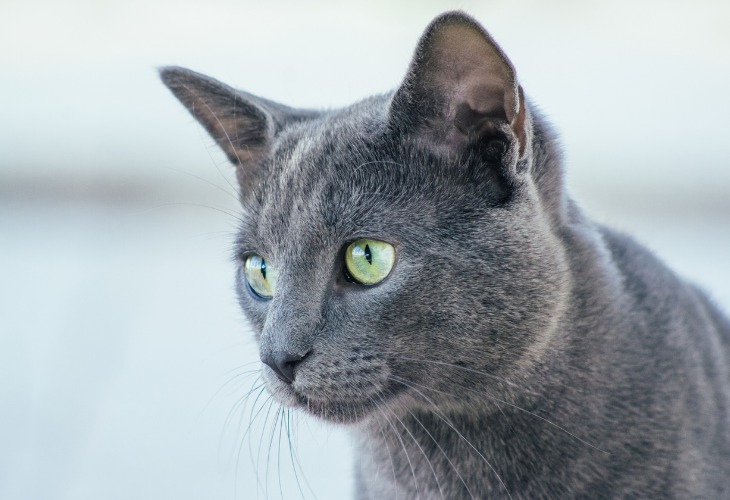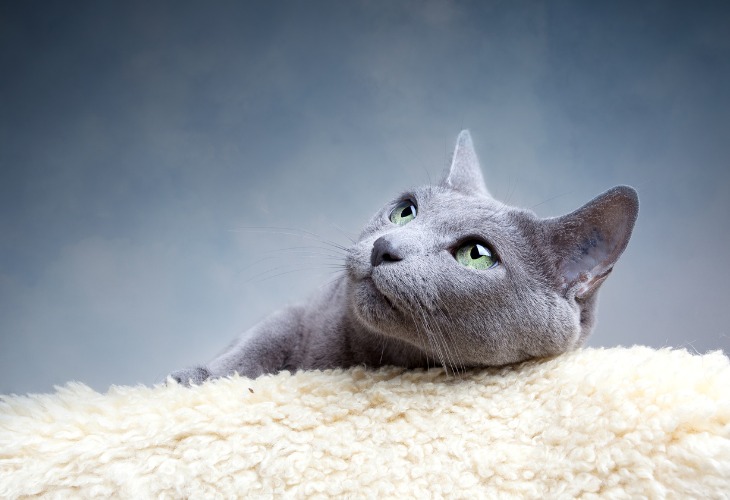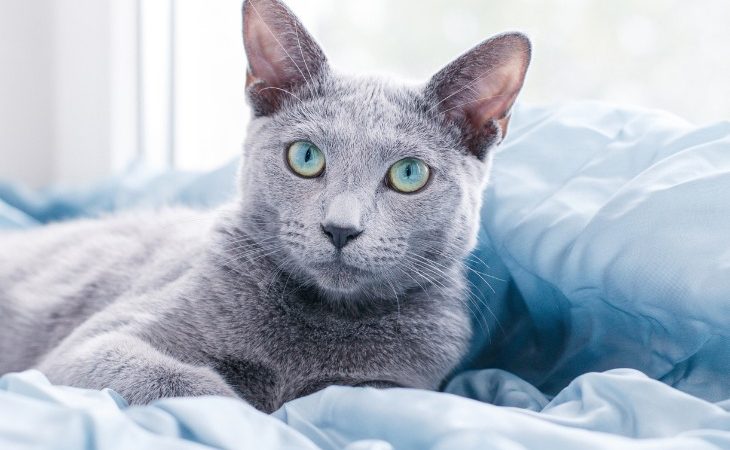Breed standard: CFA, FIFe, TICA, ACF, ACFA/CAA, CCA-AFC, GCCF | Size: Medium | Average Lifespan: 13+ years | Personality: Gentle and calm | Coat: Short / Medium-long | Origin: Russia.
The Russian Blue is an elegant and gentle cat. It adapts to all environments, but prefers quiet environments. This cat is an indoor cat.
The origins of the Russian Blue
This cat originated in Russian. But what about it’s history?
Why is it called the Russian Blue?
Similar to the origins of many cat breeds, the true origin of the breed is still being debated. We can however agree on something: the Russian Blue originated in Russia, more precisely from Arkhangelsk, in the North of Russia. This cat is believed to have adapted to the winter climate by adopting a full coat. It arrived in England in 1860, by British sailors who brought them with them via cargo shipments from India to England. Upon arriving in England, the breed appeared for the first time during the Crystal Palace Cat Show in 1875.
The history of this cat breed
During the Second World War, the breed almost went extinct. However, thanks to the efforts of European and American breeders, it survived. In particular, the different crossbreeding with the Siamese, the Chartreux and the British shorthair allowed the breed to avoid extinction. Over the years, this cat has recovered its original morphology and shape thanks to the efforts of various breeders.
The Russian Blue’s personality
It is a rather calm and graceful cat, it likes peaceful environments and hates when it is too noisy.
Why adopt a Russian Blue?
In addition to being calm, this cat can also be playful. Thanks to its dense fur, this cat can also warm you up. This breed is particularly intelligent, so be careful not to neglect it. Another particularity of this cat: they like to stay home where it is warm and safe.
Despite this, this breed can adapt to all environments. However, they prefer quiet environments. Are you in need of affection and you live alone? Then this is the cat for you, it is very cuddly and can spend hours lying at your feet to feel you at its side.
Are there any downsides to have a Russian Blue?
This cat does not like strangers and prefers to hide and run away. As they are wary by nature, they run away from everything that is foreign to them and that can disturb their daily life. If your children are particularly noisy and very active, this cat is not for you. It will take time to build a relationship of trust between you and your cat.

Affection for its owner
On the other hand, if you are not at home very often or if you travel a lot, this cat breed may feel lonely and does not like it. If you cannot spend a lot of time at home, it is best not to get a Russian or at least get another cat for your cat to play with and spend time with. This cat can get along well with other cat breeds.
The physical characteristics of the Russian blue
There are two different types of Russian Blues:
- The American type: The Russian Blue cat settled in the United States and a new Russian Blue was born. It has a lighter coat and its ears are positioned differently.
- The English type: As for the English Russian Blue, its coat is more intense than that of the American type. Its ears are also different from those of the American Russian Blue.
General
This cat is graceful, has a long neck, and a slender and muscular body. It is generally of medium size and has long legs. Its ears are spread apart and its eyes are an intense green color. The eyes are almond shaped. As for its tail, it is full of hair and dense. The coat is soft and silky.
Coat color
This cat is known for the color of its coat. It is an intense blue-gray color with silver reflections. It gives this cat an elegant look. Its coat also makes it look a lot like the Chartreux and the British Shorthair.
Caring for a Russian Blue
There are two types of Russian Blue cats:
- Russian Blue (shorthair): This variety is the most well-known. They are easy to care for and shed very little.
- Long-haired Russian Blue or Nebelung: This is another variety. Nebelung means creature of the mist. The variety is presumed to have originated in the United States.
Grooming
Since this cat has a short coat, it is easier to maintain. This breed usually only needs to be brushed once a week to smooth out the hair. Their coat is not difficult to brush.
The right environment for this cat
This breed prefers quiet and calm environments. This cat does not like noise. It also does not meow very often. Instead, they are said to make a soft and soothing sound when they meow. If you are a calm person looking for a gentle and affectionate companion, this cat will suit you.

Diet
In general, cats require a healthy and balanced diet. This breed eats nutrient-rich foods. For example, they should eat mostly high-quality animal proteins such as fish, meat, and premium kibble.
Health
Like all pets, it’s best for this cat to have a check up at the vet at least once a year. With that being said, this cat is not predisposed to any particular health issues. This breed is robust and east to take care of. This is especially so because it is an indoor cat.
Did you know?
While Russian Blues are known for their blue coat, there are black and white Russian Blues as well!
The Russian Blue at a glance
Size: 30 cm (11.8 in).
Weight: 2 to 5 kg (4.4 to 11 lbs).
Health: The Russian Blue is a robust cat which is not predisposed to any particular health issues.
Average Lifespan: 13 to 20 years.
Is the Russian Blue good with children? The Russian Blue is a playful cat who likes to be spend time with children. However, this cat does need quiet time where it can observe its environment.

